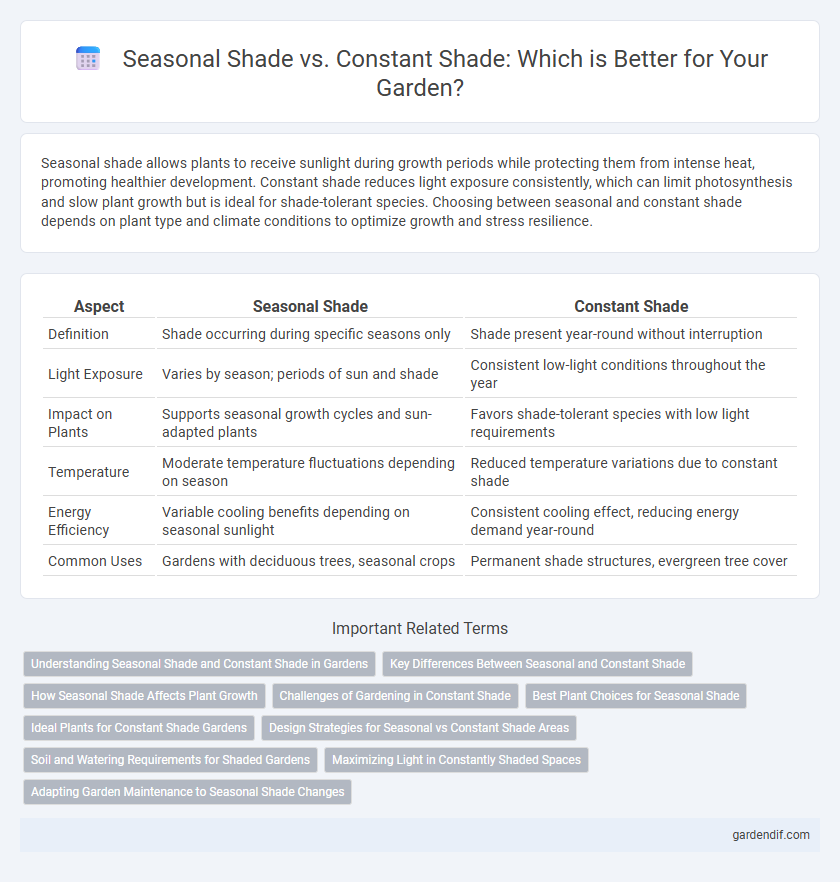
Seasonal shade vs constant shade Illustration
Seasonal shade allows plants to receive sunlight during growth periods while protecting them from intense heat, promoting healthier development. Constant shade reduces light exposure consistently, which can limit photosynthesis and slow plant growth but is ideal for shade-tolerant species. Choosing between seasonal and constant shade depends on plant type and climate conditions to optimize growth and stress resilience.
Table of Comparison
| Aspect | Seasonal Shade | Constant Shade |
|---|---|---|
| Definition | Shade occurring during specific seasons only | Shade present year-round without interruption |
| Light Exposure | Varies by season; periods of sun and shade | Consistent low-light conditions throughout the year |
| Impact on Plants | Supports seasonal growth cycles and sun-adapted plants | Favors shade-tolerant species with low light requirements |
| Temperature | Moderate temperature fluctuations depending on season | Reduced temperature variations due to constant shade |
| Energy Efficiency | Variable cooling benefits depending on seasonal sunlight | Consistent cooling effect, reducing energy demand year-round |
| Common Uses | Gardens with deciduous trees, seasonal crops | Permanent shade structures, evergreen tree cover |
Understanding Seasonal Shade and Constant Shade in Gardens
Seasonal shade in gardens occurs during specific times of the year when the sun's angle changes, providing partial sunlight that supports a wider variety of plants adapted to fluctuating light conditions. Constant shade results from permanent obstructions like buildings or dense tree canopies, creating consistently low light environments ideal for shade-tolerant species such as ferns and hostas. Understanding the difference between seasonal and constant shade helps gardeners select appropriate plants and design landscapes that thrive throughout varying light exposures.
Key Differences Between Seasonal and Constant Shade
Seasonal shade occurs during certain times of the year when the sun's position or natural elements like deciduous trees block sunlight, providing temporary relief from heat and UV rays. Constant shade is present throughout the entire day, usually due to permanent structures or evergreen foliage, offering consistent protection from sunlight regardless of season. Key differences include the variability of sunlight exposure, impact on plant growth, and temperature regulation, with seasonal shade allowing for periods of full sun and constant shade creating stable, shaded environments.
How Seasonal Shade Affects Plant Growth
Seasonal shade influences plant growth by providing variable light conditions that align with specific growth phases, promoting healthier development during critical periods such as spring and early summer. Plants exposed to seasonal shade often exhibit enhanced photosynthesis efficiency and reduced stress compared to those under constant shade, which can hinder overall growth and reduce chlorophyll production. Understanding the impact of seasonal shade helps optimize planting schedules and improve crop yields by aligning light exposure with plants' natural growth rhythms.
Challenges of Gardening in Constant Shade
Gardening in constant shade presents challenges such as limited sunlight, which restricts photosynthesis and slows plant growth, resulting in sparse foliage and weak blooms. Soil moisture tends to remain high due to reduced evaporation, increasing the risk of root rot and fungal diseases in shade-tolerant plants. Selecting species like ferns, hostas, and astilbes that adapt to low light and ensuring proper soil drainage are critical strategies for successful gardening in constant shade environments.
Best Plant Choices for Seasonal Shade
Seasonal shade provides fluctuating light conditions ideal for plants like hostas, astilbes, and bleeding hearts that thrive in partial sunlight during spring and summer. These perennials benefit from dappled shade and can withstand increased sun exposure compared to plants suited for constant shade. Selecting species such as ferns and Solomon's seal ensures resilience to changing light patterns while promoting healthy growth in seasonal shade environments.
Ideal Plants for Constant Shade Gardens
Ideal plants for constant shade gardens include hostas, ferns, and astilbes, which thrive without direct sunlight. These species have adapted to low-light environments, offering lush foliage and vibrant blooms even in deep shade. Selecting shade-tolerant perennials ensures a healthy, visually appealing garden year-round in areas with minimal sunlight exposure.
Design Strategies for Seasonal vs Constant Shade Areas
Seasonal shade design strategies prioritize deciduous trees and retractable shading devices that allow sunlight penetration during winter while providing protection in summer, optimizing thermal comfort and energy efficiency. Constant shade areas benefit from evergreen trees, permanent structures like pergolas with climbing plants, and shade sails that maintain consistent coverage year-round to reduce heat and glare. Integrating native plants adapted to local climate conditions enhances sustainability and visual appeal in both seasonal and constant shade environments.
Soil and Watering Requirements for Shaded Gardens
Seasonal shade with intermittent sunlight often requires well-draining soil that retains moisture without becoming waterlogged, supporting plants with moderate watering needs. Constant shade demands consistently moist, rich organic soil to prevent drought stress and ensure nutrient availability, as shaded areas receive less evaporation. Understanding these soil and watering distinctions helps optimize plant health and growth in shaded garden environments.
Maximizing Light in Constantly Shaded Spaces
In constantly shaded spaces, maximizing light is essential to support healthy plant growth and vibrant foliage. Utilizing reflective surfaces, light-colored walls, and strategically placed artificial lighting can enhance light availability where natural sunlight is limited. Selecting shade-tolerant plants with high photosynthetic efficiency ensures optimal use of the reduced light conditions.
Adapting Garden Maintenance to Seasonal Shade Changes
Seasonal shade varies with the sun's position, affecting light exposure and plant growth cycles, whereas constant shade provides uniform low light throughout the year. Garden maintenance must adapt to these fluctuations by selecting shade-tolerant species that thrive under varying light intensities and adjusting watering schedules to match moisture retention differences in seasonal shade. Pruning and fertilization timing should align with seasonal growth patterns to optimize plant health and garden aesthetics in shaded environments.
Seasonal shade vs constant shade Infographic

 gardendif.com
gardendif.com